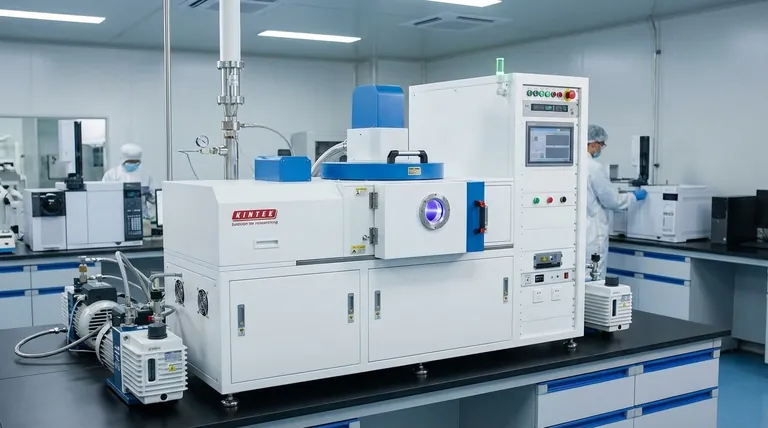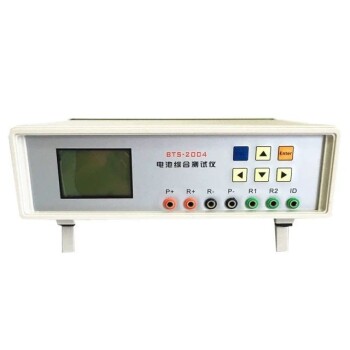The primary application of RF and DC sputtering is the deposition of thin films onto a substrate material. The critical difference lies in the type of material being deposited: DC (Direct Current) sputtering is used for electrically conductive materials like metals, while RF (Radio Frequency) sputtering is necessary for depositing non-conductive, insulating materials such as ceramics.
Your choice between DC and RF sputtering is not about which is universally "better," but which is fundamentally compatible with the electrical properties of your target material. The decision is dictated by the physics of how electrical charge is managed on the target's surface during the deposition process.

The Fundamental Difference: Managing Electrical Charge
To understand the applications, you first must understand the core technical challenge that separates these two methods: electrical charge buildup.
DC Sputtering: The Direct Approach for Conductors
In DC sputtering, a constant negative voltage is applied to the target material. This attracts positively charged gas ions (typically argon) from the plasma, which strike the target with high energy.
This collision physically knocks atoms off the target material. These ejected atoms then travel through the vacuum chamber and deposit onto your substrate, forming a thin film.
This process works seamlessly for conductive targets (like aluminum or copper) because the target can easily conduct electricity, replenishing the electrons and maintaining a stable negative charge.
The Insulator Problem: Positive Charge Buildup
If you try to use DC sputtering with an insulating target, such as silicon dioxide (a ceramic), the process fails almost immediately.
The constant bombardment of positive ions creates a localized positive charge on the surface of the non-conductive target. This positive shield repels the incoming positive ions, effectively stopping the sputtering process before it can even begin.
RF Sputtering: The Alternating Current Solution
RF sputtering solves the charge buildup problem with a clever workaround. Instead of a constant DC voltage, it uses an alternating current power source that flips the voltage at a high frequency (typically 13.56 MHz).
During the cycle's negative phase, the target is bombarded by positive ions, just like in DC sputtering.
Crucially, during the brief positive phase, the target attracts electrons from the plasma. These electrons flood the surface and neutralize the positive charge buildup from the previous cycle, effectively "cleaning" the target and preparing it for the next round of ion bombardment.
Practical Applications and Material Choices
This fundamental difference in operation dictates which technique is used for specific industrial and research applications.
When to Use DC Sputtering
DC sputtering is the go-to method for depositing conductive materials. Its simplicity, high deposition rate, and cost-effectiveness make it ideal for many applications.
Common materials include Aluminum, Copper, Titanium, Gold, and Chromium. It is widely used in the semiconductor industry for creating metal interconnects and in manufacturing for creating reflective layers on things like CDs or mirrors.
When to Use RF Sputtering
RF sputtering is essential for depositing insulating or dielectric materials. It is the only reliable way to sputter targets that cannot conduct away positive charge.
Common materials include Silicon Dioxide (SiO₂), Aluminum Oxide (Al₂O₃), and Titanium Nitride (TiN). Applications include creating anti-reflection optical coatings, durable protective layers on tools, and high-performance dielectric films in advanced electronics.
Understanding the Trade-offs
While material conductivity is the primary deciding factor, there are secondary performance and cost differences to consider.
Deposition Rate and Efficiency
DC sputtering is generally faster and more efficient than RF sputtering. The direct, continuous bombardment of ions leads to a higher deposition rate, making it more suitable for high-volume manufacturing of metal films.
Cost and Complexity
DC power systems are simpler and less expensive than their RF counterparts. RF systems require a complex power supply and an impedance matching network to efficiently deliver power to the plasma, increasing overall system cost and complexity.
Process Conditions and Film Quality
RF sputtering can sustain a stable plasma at lower operating pressures. This reduces the chance of sputtered atoms colliding with gas particles on their way to the substrate, which can result in a denser, higher-quality film.
Furthermore, the alternating nature of RF sputtering inherently reduces the electrical arcing that can sometimes occur in DC systems, leading to more uniform films with fewer defects.
Making the Right Choice for Your Goal
Your selection should be guided by the material you need to deposit, balanced against your project's cost, speed, and quality requirements.
- If your primary focus is cost-effective, high-speed deposition of metals: DC sputtering is the clear and standard choice due to its higher deposition rates and lower equipment cost.
- If your primary focus is depositing any insulating or ceramic material: RF sputtering is the necessary and effective method, as it is specifically designed to overcome the charge buildup that halts the DC process.
- If your primary focus is achieving the highest possible film quality and uniformity: RF sputtering should be considered even for some conductive targets, as its low-pressure operation and reduced arcing can produce superior results.
By understanding these core principles, you can select the right sputtering technique not just based on convention, but on the fundamental physics driving your desired outcome.
Summary Table:
| Sputtering Method | Best For Material Type | Key Advantage | Common Applications |
|---|---|---|---|
| DC Sputtering | Electrically Conductive (e.g., Metals) | High Deposition Rate, Cost-Effective | Semiconductor metal interconnects, reflective coatings |
| RF Sputtering | Non-Conductive/Insulating (e.g., Ceramics) | Prevents Charge Buildup, High-Quality Films | Optical coatings, protective layers, dielectric films |
Ready to Choose the Right Sputtering Technique for Your Project?
Navigating the choice between RF and DC sputtering is critical for achieving the perfect thin film for your application. KINTEK specializes in providing high-quality lab equipment and consumables for all your deposition needs.
Whether you are working with conductive metals or insulating ceramics, our experts can help you select the ideal sputtering solution to ensure high efficiency, superior film quality, and cost-effectiveness for your laboratory.
Contact KINTEL today to discuss your specific requirements and let us help you optimize your thin film deposition process.
Visual Guide

Related Products
- RF PECVD System Radio Frequency Plasma-Enhanced Chemical Vapor Deposition RF PECVD
- Electron Beam Evaporation Coating Oxygen-Free Copper Crucible and Evaporation Boat
- Chemical Vapor Deposition CVD Equipment System Chamber Slide PECVD Tube Furnace with Liquid Gasifier PECVD Machine
- Rotating Platinum Disk Electrode for Electrochemical Applications
- RRDE rotating disk (ring disk) electrode / compatible with PINE, Japanese ALS, Swiss Metrohm glassy carbon platinum
People Also Ask
- What is the principle of plasma enhanced chemical vapor deposition? Achieve Low-Temperature Thin Film Deposition
- What are the applications of PECVD? Essential for Semiconductors, MEMS, and Solar Cells
- What are the benefits of PECVD? Achieve Superior Low-Temperature Thin Film Deposition
- What is plasma activated chemical vapour deposition method? A Low-Temperature Solution for Advanced Coatings
- Why is PECVD environment friendly? Understanding the Eco-Friendly Benefits of Plasma-Enhanced Coating


















